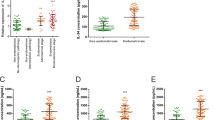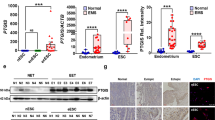Abstract
The chemokine thymus-expressed chemokine (TECK), which regulates T-cell development and tissue-specific homing, has been identified as a potential contributor to the pathogenesis and progression of endometriosis. Dioxin (2,3,7,8-tetrachlorodibenzo-p-dioxin, TCDD), an air pollutant, and estrogen also appear to be involved in endometriosis. Both endometrial stromal cells (ESCs) and the combination of 17β-estradiol and TCDD increase the secretion of TECK in the endometriosis-associated cells and promote the invasiveness of ESCs by increasing expression of matrix metalloproteinase (MMP)-2 and MMP-9. Anti-TECK neutralizing antibodies can effectively inhibit the invasiveness of ESCs and the expression of MMP-2 and MMP-9 in the cells. Interestingly, the expression of chemokine C receptor 9 (CCR9) and its ligand TECK increases significantly in the endometriotic milieu of patients with endometriosis. Therefore, the over-expressed TECK interacts with CCR9 on the ESCs in the endometriotic milieu, which may contribute to the onset and progression of endometriosis.
This is a preview of subscription content, access via your institution
Access options
Subscribe to this journal
Receive 12 digital issues and online access to articles
$119.00 per year
only $9.92 per issue
Buy this article
- Purchase on Springer Link
- Instant access to full article PDF
Prices may be subject to local taxes which are calculated during checkout






Similar content being viewed by others
References
Witz CA . Current concepts in the pathogenesis of endometriosis. Clin Obstet Gycol 1999; 42: 566–585.
Melega C, Balducci M, Bulletti C, Galassi A, Jasonni VM, Flamigni C . Tissue factors influencing growth and maintenance of endometriosis. Ann N Y Acad Sci 1991; 622: 256–265.
Visser CE, Tekstra J, Brouwer-Steenbergen JJ . Chemokines produced by mesothelial cells: huGRO-alpha, IP-10, MCP-1 and RANTES. Clin Exp Immunol 1998; 112: 270–275.
Garcia-Velasco JA, Arici A . Chemokines and human reproduction. Fertil Steril 1999; 71: 983–993.
Kayisli UA, Mahutte NG, Arici A . Uterine chemokines in reproductive physiology and pathology. Am J Reprod Immunol 2002; 147: 213–221.
Zabel BA, Agace WW, Campbell JJ, Heath HM, Parent D, Roberts Al, et al. Human G protein-coupled receptor GPR-9-6/CC chemokine receptor 9 is selectively expressed on intestinal homing T lymphocytes, mucosal lymphocytes, and thymocytes and is required for thymus-expressed chemokine-mediated chemotaxis. J Exp Med 1999; 190: 1241–1256.
Vila-Coro AJ, Rodriguez-Frade JM, Martin De AA, Moreno-Ortiz MC, Martinez-A C, Mellado M . The chemokine SDF-1α triggers CXCR4 receptor dirmerization and activates the JAK/STAT pathway. FASEB J 1999; 13: 1699–1710.
Majka M, Janowska-Wieczorek A, Ratajczak J, Kowalska MA, Vilaire G, Pan ZK, et al. Stromal-derived factor 1 and thrombopoietin regulate distinct aspects of human megakaryopoiesis. Blood 2000; 96: 4142–4151.
Ganju RK, Dutt P, Wu L, Newman W, Avraham H, Avraham S, et al. Beta-chemokine receptor CCR5 signals via the novel tyrosine kinase RAFTK. Blood 1998; 91: 791–797.
Spuijbroek MDEH, Dunselman GAJ, Menheere PPCA, Evers JLH . Early endometriosis invades the extracellular matrix. Fertil Steril 1992; 58: 929–933.
Burner KL, Matrisian LM, Rodgers WH, Gorstein F, Osteen KG . Suppression of matrix metalloproteinases inhibits establishment of ectopic lesions by human endometrium in nude mice. J Clin Invest 1997; 99: 2851–2857.
Vu TH, Werb Z . Matrix metalloproteinases: effectors of development and normal physiology. Genes Dev 2000; 14: 2123–2133.
Kokorine I, Nisolle M, Donnez J, Eeckhout Y, Courtoy PJ, Marbaix E . Expression of interstitial collagenase (matrix metalloproteinase-1) is related to the activity of human endometriotic lesions. Fertil Steril 1997; 68: 246–251.
Wenzl RJ, Heinzl H . Localization of matrix metalloproteinase-2 in uterine endometrium and ectopic implants. Gynecol Obstet Invest 1998; 45: 253–257.
Cox KE, Piva M, Sharpe-Timms KL . Differential regulation of matrix metalloproteinase-3 gene expression in endometriotic lesions compared with endometrium. Biol Reprod 2001; 65: 1297–1303.
Rodgers WH, Osteen KG, Matrisian LM, Navre M, Giudice LC, Gorstein F . Expression and localization of matrilysin, a matrix metalloproteinase, in human endometrium during the reproductive cycle. Am J Obstet Gynecol 1993; 168: 253–260.
Chung HW, Hur SE, Park MH . Matrix metalloproteinase-2, membranous type 1 matrix metalloproteinase, and tissue inhibitor of metalloproteinase-1 expression in ectopic and eutopic endometrium. Fertil Steril 2002; 78: 787–795.
Collette T, Maheux R, Mailloux J, Akoum A . Increased expression of matrix metalloproteinase-9 in the eutopic endometrial tissue of women with endometriosis. Hum Reprod 2006; 21: 3059–3067.
Rier S, Foster WG . Environmental dioxins and endometriosis. Toxicol Sci 2002; 70: 161–170.
Cramer DW, Wilson E, Stillman RJ, Berger MJ, Belisle S, Schiff I, et al. The relation of endometriosis to menstrual characteristics, smoking, and exercise. JAMA 1986; 255: 1904–1908.
Dizerega GS, Barber DL, Hodgen GD . Endometriosis: role of ovarian steroids in initiation, maintenance and suppression. Fertil Steril 1980; 33: 649–653.
Kiesel L, Rennebaum B . Mechanisms involved in the hormonal treatment of endometriosis. Prog Clin Biol Res 1990; 323: 179–196.
Sensky TE, Liu DT . Endometriosis: association with menorrhagia, infertility and oral contraceptives. Int J Gynaecol Obstet 1980; 17: 573–578.
Shi YL, Luo XZn, Zhu XY, Hua KQ, Zhu Y, Li DJ . Effects of combined 17β-estradiol with TCDD on secretion of chemokine IL-8 and expression of its receptor CXCR1 in endometriotic focus-associated cells in coculture. Hum Reprod 2006; 21: 870–879.
Yu J, Wang Y, Zhou WH, Wang L, He YY, Li DJ . Combination of estrogen and dioxin is involved in the pathogenesis of endometriosis by promoting chemokine secretion and invasion of endometrial stromal cells. Hum Reprod 2008; 23: 1614–1626.
Egorina EM, Sovershaev MA, Osterud B . In-cell western assay: a new approach to visualize tissue factor in human monocytes. J Thromb Haemost 2006; 4: 614–620.
Meurens F, Whale J, Brownlie R, Dybvig T, Thompson DR, Gerdts V . Expression of mucosal chemokines TECK/CCL25 and MEC/CCL28 during fetal development of the ovine mucosal immune system. Immunology 2008; 120: 544–555.
Zaballos A, Gutiérrez J, Varona R, Ardavin C, Márquez G . Identification of the orphan chemokine receptor GPR-96 as CCR9, the receptor for the chemokine TECK. J Immunol 1999; 162: 5671.
Youn BS, Kim CH, Smith FO, Broxmeyer HE . TECK, an efficacious chemoattractant for human thymocytes, uses GPR-9 -6/CCR9 as a specific receptor. Blood 1999; 94: 2533–2536.
Yu CR, Peden KWC, Zaitseva MB, Golding H, Farber JM . CCR9A and CCR9B: two receptors for the chemokine CCL25/TECK/Ckβ-15 that differ in their sensitivities to ligand. J Immunol 2000; 164: 1293–1305.
Norment AM, Bogatzki LY, Gantner BN, Bevan MJ . Murine CCR9, a chemokine receptor for thymus-expressed chemokine that is up-regulated following pre-TCR signaling. J Immunol 2000; 164: 639–648.
Carramolino L, Zaballos A, Kremer L, Villares R, Martín P, Ardavín C, et al. Expression of CCR9 β-chemokine receptor is modulated in thymocyte differentiation and is selectively maintained in CD8+T cells from secondary lymphoid organs. Blood 2001; 97: 850–857.
Uehara S, Song K, Farber JM, Love PE . Characterization of CCR9 expression and CCL25/TECK responsiveness during T cell development: CD3highCD69+ thymocytes and γ8TCR+thymocytes preferentially respond to CCL25. J Immunol 2002; 168: 134–142.
Bowman EP, Campbell JJ, Soler D, Dong Z, Manlongat N, Picarella D, et al. Butcher. Development switches in chemokine response profiles during B cell differentiation and maturation. J Exp Med 2000; 191: 1303–1318.
Kao LC, Germeyer A, Tulac S, Lobo S, Yang JP, Taylor RN, et al. Expression profiling of endometrium from women with endometriosis reveals candidate genes for disease-based implantation failure and infertility. Endocrinology 2003; 144: 2870–2881.
Osteen KG, Yeaman GR, Bruner-Tran KL . Matrix metalloproteinases and endometriosis. Semin Reprod Med 2003; 21: 155–164.
Wu MH, Sun HS, Lin CC, Hsiao KY, Chuang PC, Pan HA, et al. Distinct mechanisms regulate cyclooxygenase-1 and -2 in peritoneal macrophages of women with and without endometriosis. Mol Hum Reprod 2002; 8: 1102–1110.
Kayisli UA, Mahutte NG, Arici A . Chemokines and human reproduction. Fertil Steril 1999; 71: 983–993.
Ulukus M, Ulukus EC, Seval Y, Zheng W, Arici A . Expression of interleukin-8 receptors in endometriosis. Hum Reprod 2005; 20: 794–801.
Mulayim N, Savlu A, Guzeloglu-Kayisli O, Kayisli UA, Arici A . Regulation of endometrial stromal cell matrix metalloproteinase activity and invasiveness by interleukin-8. Fertil Steril 2004; 81: 904–911.
Bradundmeier AG, Nowak RA . Cytokines regulate matrix metalloproteinases in human uterine endometrial fibroblast cells through a mechanism that does not involve increases in extracellular matrix metalloproteinase inducer. Am J Reprod Immunol 2006; 56: 201–214.
Acknowledgements
This work was supported by the National Basic Research Program of China (2006CB944007, to DJ Li), the National and Shanghai Leading Academic Discipline Project (211XK22, to DJ Li) and the Program for Outstanding Medical Academic Leader of Shanghai (to DJ Li). The human peritoneal mesothelial cell line (HMrSV5) was generously provided by Professor Jian Yao (The First People’s Hospital, Shanghai, China)
Author information
Authors and Affiliations
Rights and permissions
About this article
Cite this article
Wang, Y., Yu, J., Luo, X. et al. Abnormal regulation of chemokine TECK and its receptor CCR9 in the endometriotic milieu is involved in pathogenesis of endometriosis by way of enhancing invasiveness of endometrial stromal cells. Cell Mol Immunol 7, 51–60 (2010). https://doi.org/10.1038/cmi.2009.102
Received:
Revised:
Accepted:
Published:
Issue Date:
DOI: https://doi.org/10.1038/cmi.2009.102
Keywords
This article is cited by
-
Anti-inflammatory cytokines in endometriosis
Cellular and Molecular Life Sciences (2019)
-
CCR9 in cancer: oncogenic role and therapeutic targeting
Journal of Hematology & Oncology (2016)
-
CD4+Foxp3+ regulatory T cell differentiation mediated by endometrial stromal cell-derived TECK promotes the growth and invasion of endometriotic lesions
Cell Death & Disease (2014)



